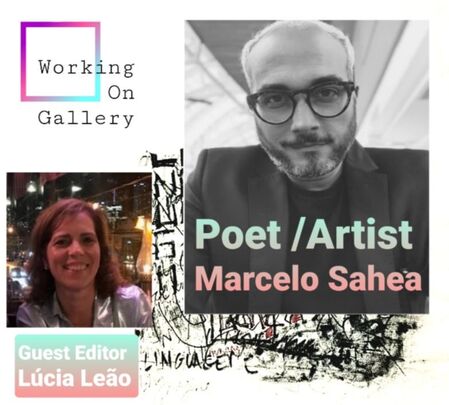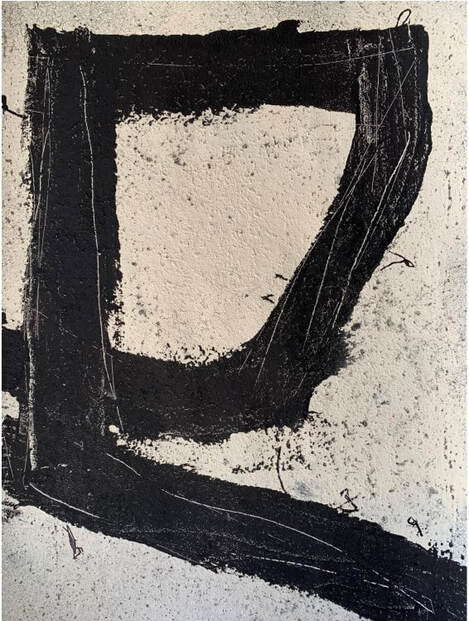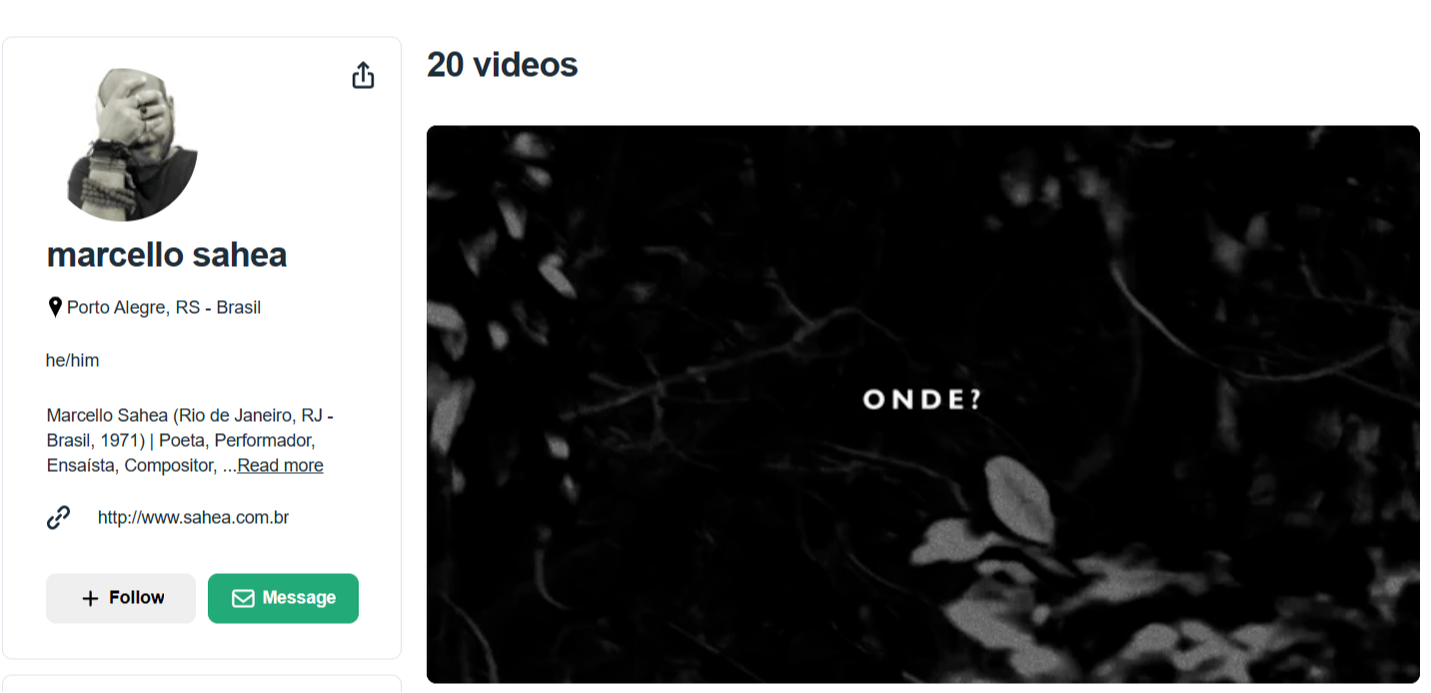|
I am so excited to introduce Lúcia Leão's second curation. Her previous article was with Angela Quinto. In this article, Leão chose visual poetry projects by a Brazilian artist/poet, Marcelo Sahea, along with a Brazilian poet, Dirceu Villa. INTRODUCING MARCELLO SAHEALúcia Leão - Guest Editor When Naoko Fujimoto invited me to select guests to her gallery, I thought of Brazilian artists and replicated Fujimoto’s gesture. I invited Dirceu Villa, a Brazilian poet who lives in São Paulo, to be part of the project. He helped me find and contact visual poets in Brazil. Marcelo Sahea is the second artist. The three of us are introducing to you in this vibrant collective space that Fujimoto’s Working on Gallery opens to us. Poet, essayist, translator, performer, composer, visual and sound artist, Marcello Sahea was born in Rio de Janeiro in 1971. He has published four books: Carne Viva, Leve, Nada a Dizer, and Objeto Intersemiótico, and the albums Pletórax and Preparando Meu Próximo Erro. He works with video art, and has participated in digital art shows, exhibitions of sound poetry, visual poetry, and video poetry in Brazil and in several countries. Marcello has performed his work in Brazil, Mexico, and Spain. Dirceu Villa (1975) is a Brazilian author of seven books of poetry, the latest of which is ciência nova (2022). His work has been published in magazines and anthologies such as Rattapallax (USA), Alforja (Mexico), alba Londres (UK), Neue Rundschau (Germany), Retendre la corde vocale (France) and Atelier (Italy). He has translated Ezra Pound, Joseph Conrad, Mairéad Byrne, and Jean Cocteau into Portuguese. INFINITE DEMANDEssay by Marcelo Sahea Ana Hatherly used to say: What distinguishes an individual is the singularity of voice, even on the sacred level. Immersed in uncertainties, I say this image−of a distinction−is not limited only to speech, to the tongue, or even to the oral cavity. The movements hands and feet make in their errant paths, their exuberance, the economic strokes full of tension, reluctant, nimble, temporary, or surreptitious emulate this orality of mine on the surface of a support, be it a sheet of paper, a white canvas or the space that surrounds me. “Making” is the only possibility, and this axiom continually resonates in my creative process in the attempt at condensing errors into calligraphy. In one of the essays in my book Objeto Intersemiótico - escritos sobre poesia expandida [Intersemiotic Object – Texts about Expanded Poetry, not available in English], I say that to err is to walk, not to wander aimlessly, but to wander not at random (In Portuguese, the expression for “at random” is “a esmo,” and the verb “esmar”, from Latin “aestimare,” means “to judge, calculate.”) At times, the unexpected (the novelty, the new) reveals itself in my work in an asymmetrical weaving imposed by the laborious repetition of verses, sentences, neologisms, vocabulary fragmentation, etc. Sometimes, materials and tools affect each other, through fortuitous textures, accidental collages, created by the attempt at blurring the limits of coherence or only the variability of procedures. I see my conversation with visual arts as a corollary of my work with the word. The word is the foundation of my work. I started to make poetry professionally when I was 15, combining verses, painting, and drawing. With the advent of the internet, I migrated to what has conventionally been called “digital poetry”—poetry made with the computer—and that is where I have stayed for at least 20 years. Today I revisit the guiding principles for my work in a circular process, practicing what I now also consider “digital poetry,” but one made with my fingers, with my own digits, my own fingerprints. Repetition and chance are substantial concepts that permeate the way I have been inhabiting the condition of a poet, since I was nine years old. Perhaps today, with these works, I am looking for another condition, one that leads me to unknown or untraveled paths. After all, as René Char said, “Each act is virgin, even the repeated ones.” Porto Alegre - RS Brazil / March 2023 Essay by Dirceu Villa Marcello Sahea is one of the very few in Brazil who are developing a work that is both poetry and visual arts, and a work that becomes increasingly complex. He is constantly incorporating new layers to his practice. In the beginning, Brazilian concrete poetry was a fundamental reference, but now Marcello’s art has become so unique that it would be difficult to establish its driving forces without tracing a huge map of connections between word, image, and sound. In its graphic inventiveness, one could see Edgard Braga (1897-1985) as a magnetic part of that field, but also, in its vortex, we would definitely find Jean-Michel Basquiat (1960-1988): the mixture of a raw, fierce take on the materials gets combined with the sophistication of its language, its ductile fluidity, and an almost infinite variation of possibilities. Marcello’s remarkable material approach to the making of such poetry that is visual arts is not his only strong suit: his vocal performance is as complex as his usage of the image, tending to a musical creation that borrows instrumental interventions from percussion and digital soundscapes and takes them to a vivid operation inside the words themselves. The same can be said of his awareness of design and patterning. The polysemic nature of his distortions of words has, admittedly, a source in James Joyce (1882-1941), and, in this sense, it can evoke numerous meanings by tweaking two or more words into a new fertile one. In the works presented here, the verbovisual entanglement is at full display, but it is also interesting to keep in mind all his wonderful, singular ways of making (here a very precise word) poetry. Marcello Sahea’s salt, sand, and sawdust are spread out and glued in ways that can help the reader become the poet−get closer, squint their eyes, and notice the texture. The work with illegibility and small letters is part of this move to promote interaction and engagement. Besides being a poet and visual artist, Marcello is also a body therapist. “The body is a hiding place. The body hides me.” After experimenting with feet calligraffiti and noticing his feet were learning to write, he went back to using his hands for the pieces with calligraphy. Marcello wants the unlearning, to be surprised by what he creates. With the distortion of a single letter a new body is visually born. He defines himself as a follower of Joan Brossa, the Catalan poet and graphic artist. Many of his works are homages to Brossa. In his art, Marcello often plays with shadows, with visual echoes of the lines that compose words and sentences. In some of his pieces, there are spaces between words big enough to allow the significance of letters to be stretched out from their usual arrangement. There are extensions and breaks in the images. A new time for fruition is produced. Marcello can be described as a man of few words if we consider part of his work presented here. Or of many, if we also consider his poetry performed and sung into magic through verbal rituals of repetition, and repetition, and expansion. (Some of his performances can be found here) Growing up, Marcello had the presence of the word-sound, of music, very near. His father was a songwriter and a poet who collected vinyl records. It was through him that Marcello came to know Caetano Veloso’s album “Araçá Azul,” which awakened in him the desire to explore more deeply the experimental nature of words, of the word performed. This continuous research is taking him back now, again, to his own body as an instrument. Guest Editors:
Lúcia Leão is a translator and a writer originally from Rio de Janeiro, Brazil. Her work has appeared in South Florida Poetry Journal, SWWIM Every Day, Gyroscope Review, Chariton Review, Harvard Review Online, and elsewhere. It is also included in the anthology Grabbed: Poets and Writers on Sexual Assault, Empowerment & Healing. Lúcia holds a master’s degree in Brazilian literature (UERJ–RJ, Brazil) and a master’s degree in print journalism (University of Miami–FL, USA). She is a book reviewer for RHINO literary magazine, a volunteer copyeditor for South Florida Poetry Journal, and a board member for TCLA, a non-profit organization based in West Palm Beach, Florida. She has been living in South Florida for 30 years. |
Archives
July 2024
|
フジハブ
Welcome to FUJI HUB: Waystation to Poetry, Art, & Translation. This is not your final destination. There are many links to other websites here, so please explore them!
Welcome to FUJI HUB: Waystation to Poetry, Art, & Translation. This is not your final destination. There are many links to other websites here, so please explore them!
What are you looking for?
FUJI HUB Directory
Popular Sites:
Gallery of Graphic Poems
Working On Gallery
(Monthly New Article by Writers & Artists)
About Naoko Fujimoto
Contact
Naoko Fujimoto Copyright © 2024
FUJI HUB Directory
Popular Sites:
Gallery of Graphic Poems
Working On Gallery
(Monthly New Article by Writers & Artists)
About Naoko Fujimoto
Contact
Naoko Fujimoto Copyright © 2024










